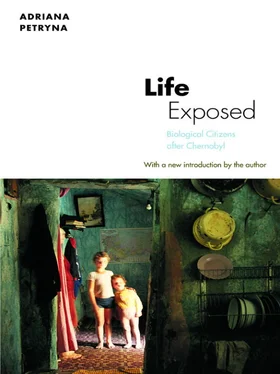I asked Anton several times to show me a computerized tomographic image that he said had been made during that time, an image that might show evidence of radiation-induced organic brain damage. My requests were made in vain. “Later,” he always used to say. Halia told me that many workers did not want to be medically screened because “they were afraid” of how their diagnoses might be used against them in the context of work (see chapter 4). Researchers in the Radiation Research Center’s neurology ward confirmed this initial resistance among workers to be diagnosed.
After his accident and medical treatment, Anton was seen as a liability and no longer hirable as a driver. As a sufferer, he received a minimum income from the state. Yet this short-term stability was disrupted in 1994, when his newly divorced daughter Iryna returned from Siberia with a two-year-old daughter. Soon Anton realized that he couldn’t support this new family; it was up to him to fight for his disability to obtain an additional pension. Right then, Anton underwent new medical examinations, but by that time the system had become much more closed and selective. He had not learned to be an efficient administrator of his suffering. As a result, he lacked a medicalized specificity or role.
By February 1996, as Halia told me, Anton became despairing and preoccupied with his own death. He had visited the Oil Institute, where he learned that some of his coworkers, also sent to Chernobyl, had already died. This knowledge had a harrowing psychological effect on him. He became delusional and told Halia to do things like “take his clothes out of the apartment and stuff them into a hearse.” He called his mother and other relatives whom he had not seen since 1968 “to say goodbye.” He even picked out the suit that he would wear for his funeral and burial. He told his wife that he didn’t “want others profiting at his expense or taking advantage of him while he was dead.” Anton even instructed Halia to slit the back of his suit with scissors, “so that when the grave robbers come they only take my clothes and leave my body alone.”
How can we approach Anton’s delusional behavior and imagery (which the couple recollected with cautious humor)? First, the organic etiology of his illness remained unproven, but it was also not disproven. A psychological approach might consider Anton’s delusion in terms of his relations to the many women in his life and to his troubled fatherhood, his impotence, and his loss of work. The content of the delusional imagery also suggests that Anton was mourning a death—the death of a social world in which he once recognized himself as being human. He was also exposing a moral and medicalized system that had come to prevail and that haunted him, leaving him exposed and physically vulnerable. Anton’s delusion was indicative of a new illness, produced in the interstices of a nuclear tragedy, lost social supports, and familial uncertainties. It was at this moment that years of Soviet psychological training gave way to violent instincts. At the same time, through his delusion, Anton voiced his resolve to regain his life at all costs.
Anton fell into a fit and physically abused Halia in February 1996. After one week’s stay in the Pavlova’s Ward 1, orderlies noticed his identity documents and transferred him into the hospital’s Chernobyl ward, where he met Lev and began to recognize his rights as a sufferer. He learned that he had, comparatively speaking, more rights as a sufferer than as a mentally ill person. He was discharged from the Pavlova’s Ward 3 with a diagnosis that read, “Organic brain injury of a vascular origin, depression and lowered intellectual capacity.” Lev helped Anton make his way into the Radiation Research Center to undergo several specialized medical evaluations. He reported these bodily complaints upon his entry: “Headaches increase with emotional pressure, more on the left side of the head; head spins, poor memory, irritability, pains in the heart, pains all over the body.” But now Anton’s confusion set in. At the center, he was diagnosed by the neurologists with “hypertonia, gastroduodenitis, and ischemia.” Tolkach, the tough-minded medical-legal psychiatrist, added, “with hypochondriacal syndrome and hysteria” ( vnushenni reaktsii or induced reactions). Anton suffered a legal blow. The psychiatrist’s diagnoses suggested that the origin of his illness was related to psychological “self-placement” rather than to a bona fide organic cause.
It was during this period that I was introduced to the Nimovs. Having put himself under the scrutiny of the Radiation Research Center, Anton worried that he would lose his Chernobyl status altogether in the next round of annual examinations. Members of the fund adopted Anton’s situation as an exemplary case of the increased marginalization of the Chernobyl sufferers. These social dynamics shaped what Nancy Scheper-Hughes calls a “political economy of emotions” and a “travesty of interaction,” where the situation of a marginalized person is locked into an intimate and personal relationship with authority figures (1992:126). Anton, once a dutiful worker, came to be dependent on and even penalized by the system and its representations of him. His psychological profile was generated within the legal contours of the state; he was both passive and at war with its mechanisms of benevolence. In the process, “the man was left with the task of reclaiming, little by little, the former human content of his life” (Scheper-Hughes 1992:127).
I went to talk with Tolkach at the center about the Nimov matter. Along with his other diagnoses, Tolkach also indicated “logoneurosis” in Anton’s medical records. He explained it as a form of “traumatic, broken speech” but added that “he can speak normally,” implying that Anton was engaged in dissimulation. “He’ll make theater and then stop and seek a quiet place. Real mania just keeps going, without stopping.” “What about his suicidal thoughts?” I asked the psychiatrist. “He won’t kill himself, he says he’s wanted to kill himself for two years now. He really won’t. He’ll keep creating theater instead.” Tolkach insisted that Anton had a personality disorder, and admonished me “to never pity these people. They will draw you into their concerns like a dark force. They will cheat you just as they cheat the doctor.” I understood his concerns. Yet it seemed there was no medical classification that could rightfully account for the new disorder Anton was experiencing. Though his symptoms correlated with a general Chernobyl syndrome, he initially lacked the bureaucratic acumen to be accorded a higher disability status. What Tolkach didn’t realize is the extent to which Anton himself despised the social role he was beginning to master.
In July, Anton and Halia arranged a second lavish dinner. This time the couple invited Vadim Nezdorov, a neurologist and staff member of the neurological ward of the local hospital in the microraion. Anton introduced me to Nezdorov as “the one who is writing a book about me” to increase his symbolic capital with the neurologist. Anton and Halia hoped that as a result of their inviting him to dinner, Nezdorov would be motivated to write diagnoses and letters supporting Anton’s claim of disability. Soon we were joined by Lev, a key link in what I saw evolving into a kind of medical potlatch: “total services of an agonistic type” (Mauss 1990:7). Anton reciprocated Lev’s earlier help by giving Lev access to his private neurologist. Lev was eager to know this specialist, for whose knowledge he would find good use (Nezdorov subsequently promised him Prozac).
I was never able to fathom the exact quantities of goods or services being exchanged here. There seemed to be little hope that the agitation in this room could ever be fully appeased by such exchanges. Those services are better understood as promises, connections, knowledge, and social ties that functioned like advances of credit, to be used in the future when needed. This institution of exchange was part of an informal economy operating in parallel with the state, where diagnoses, symptoms, and medical access were traded. The outcome of these exchanges was a changed, medicalized self.
Читать дальше












